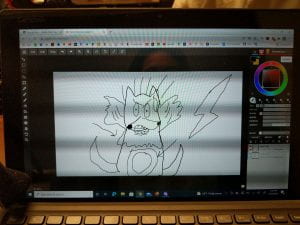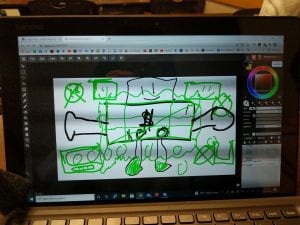My express/experience project is about how reaching out for help when you’re struggling with mental illness can be difficult. Often times, one can forget that it is even an option. To help players experience this, I’ve created what is essentially a score that asks players to sort playing cards from their hand into piles in front of them. The secret is that they can collaborate and help each other, but card game conventions makes them assume otherwise. The game always (in the two times I’ve playtested it) results in players reaching a point where they cannot progress forward but still have cards left in their hands. They would then ask about what to do from there. Eventually, they would ask a question along the lines of “can we trade cards?” or “can we collaborate?” This sparks an “a-ha” moment that results in the players quickly winning the game by working together.
A large part of the inspiration for this project actually comes from a critique I received regarding a different game I was designing. I was told that the other game was too much like “multiplayer solitaire.” It was meant to be a bad thing but I thought it could be turned into something more. I felt like a “multiplayer solitaire game” would be similar to how some people struggle through life alone, avoiding seeking the help of others, even though many would be willing to give it.
Another contribution to this project was the scores Fluxus artists have made. The way scores were very open to individual interpretation made me realize that I could essentially trick the player into thinking that there is a rule where there is none with my wording.
Since the rules and its phrasing are such a large part of what makes this project work, I will include the rules I read aloud to players during the playtest and during the final iteration:
Playtest:
This game is played with 2 – 4 players sitting in a circle. Use a deck of cards with the jokers removed. Start with seven cards in your hand. Allocate three spaces in front of you to place cards. The first cards placed in these three spaces can be any card. Subsequent cards have to be one rank different from the card previously placed (ie. 9 or Jack can be played onto a 10). Ace cannot be placed on a King and vice versa. Aces can be played onto a 2 and vice versa. You can pick up as many cards as you wish to reorganize. You can only draw cards if the number of cards in your hand is below seven. Your goal is to place as many cards down as you can.
Final Iteration:
This game is played with 2 – 4 players sitting in a circle. Use a deck of cards with the jokers removed. Shuffle the cards thoroughly and distribute cards to each player so that each player has seven cards. Allocate three spaces in front of each player to place cards face up. The first cards placed in these three spaces can be any card. Subsequent cards have to be one rank different from the card previously placed (ie. 9 or Jack can be played onto a 10). Ace cannot be placed on a King and vice versa. Aces can be played onto a 2 and vice versa. You can pick up as many cards from the three stacks as you wish to reorganize. You can only draw new cards from the deck if the number of cards in your hand is below seven. You win when you place all your cards. You do not lose if someone else wins. There are no other rules.
I made some changes due to the questions that people asked during the playtest. I tried to reword it so that it answered any potential questions people had other than the essential “can we work together?” question.
I asked one of the playtesters what he thought the game was about. He said it was about helping others. I would call this a success in terms of conveying my intended message. Even though he didn’t mention the part about how it can be difficult to ask for help, I think the experience of the game made him understood that without me or him saying it.



